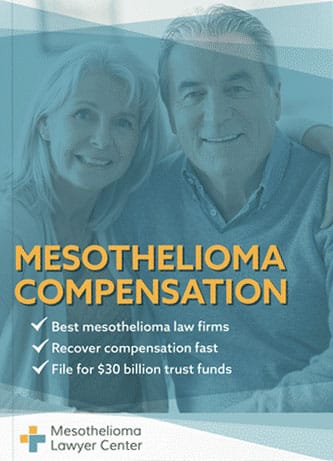The leading cause of malignant mesothelioma cancer is prolonged and repeated asbestos exposure. Inhaled asbestos fibers cause tissue damage that can lead to cancer, most frequently around the lungs. Most people with mesothelioma were exposed to asbestos in the workplace.
If you or a loved one suffer from mesothelioma, asbestos-related lung cancer, or asbestosis, you may qualify for substantial compensation. Currently, there is over $30 billion in asbestos trust funds awaiting those who’ve been diagnosed with an asbestos illness. Fill out our form to get a free Financial Compensation Packet. You’ll learn about qualified mesothelioma lawyers in your area, how to get paid in 90 days, how to file a claim for the asbestos trust funds, and more.


FREE Financial Compensation Packet
- Info on law firms that will recover your HIGHEST COMPENSATION
- Learn how to get paid in 90 days
- File for your share of $30 billion in trust funds

What Is Most Likely to Cause Mesothelioma?
Asbestos exposure is the leading and most likely cause of mesothelioma.
Before the 1970s, many industries used asbestos and asbestos-containing materials (ACMs) because of their ability to insulate against heat and protect against fire.
After extensive research and investigations determined that asbestos is extremely harmful to people, most businesses and manufacturers stopped using it. However, this was decades after extensive exposure in millions of people.
Even though experts determined that asbestos was dangerous, several businesses continued to use it. It was a matter of profits over care for workers.
Unlike other forms of cancer, mesothelioma doesn’t have a long list of causes. One of its alternate names is asbestos cancer because the primary cause of mesothelioma is long-term exposure to asbestos.
Who Is at Risk for Mesothelioma?
Asbestos exposure is the leading cause of mesothelioma, but not everyone knows how much they were exposed to in the past or if they were exposed at all. These are some of the most critical risk factors for a mesothelioma diagnosis:
- Worked in an industry that used asbestos
- Served in the military
- Older age and male
- Lived with someone who worked with or around asbestos
- Family history of mesothelioma
Some of the jobs that most put people at risk for asbestos exposure included:
- Construction
- The military (especially the Navy)
- Automotive repair work, especially brakes and clutches
- Industrial plants and factories
- Asbestos products plants
- Vermiculite processing plants
- Ship repair and shipbuilding
People who worked with asbestos have the highest risk of mesothelioma. Also at risk are people who lived with them. Family members were often exposed at home through secondhand exposure.
Workers inadvertently brought asbestos fibers home on their clothing, causing repeated exposure. Some of these family members later developed mesothelioma.
Asbestos and Mesothelioma Studies
In 2009, the International Agency for Research on Cancer (IARC) confirmed the investigations and findings and released a statement that the primary cause of mesothelioma is asbestos exposure.
The statement indicated that people who worked around asbestos daily run the highest risk of getting mesothelioma. The most common work sites associated with using asbestos include:
- Factories and industrial sites
- Steel mills
- Asbestos and other mines
- Asbestos processing plants
People at home are also at risk, especially if they live near a naturally occurring asbestos deposit site or in an older home built during peak asbestos use.
Two other studies performed in 2010 by the Mesothelioma Applied Research Foundation and the Cancer Institute revealed again that the leading cause of mesothelioma is asbestos exposure.
Once the fibers enter, it’s almost impossible for the body to expel them. The fibers then begin to attack the mesothelium, which in turn causes lesions and tissue damage.
Over time, cells in the damaged tissue may become cancerous and form tumors. It can then take up to 50 years for the first symptoms of mesothelioma to surface.
How Does Asbestos Cause Mesothelioma?
People are exposed to asbestos by inhaling the delicate fibers that the mineral produces. These fibers then get lodged in the lungs. Someone can also unknowingly swallow asbestos, and the fibers make their way down to the abdominal area.
Asbestos fibers in the body can cause significant tissue damage, causing scarring and inflammation. In some people, this leads to mesothelioma. Although scientists and physicians are still trying to determine exactly why asbestos fibers cause cancer, researchers have several ideas:
- Changes in Genetics. Asbestos can disrupt mesothelial cells, which are naturally occurring cells in the body. This, in turn, hinders the functions of the cells, which can lead to cancer.
- Inflammation of Cells. When the body’s cells become irritated, inflammation and scarring occur. Consequently, it leads to cell damage and cancer.
- Free Radicals. Asbestos produces free radicals in the body. Once this happens, DNA can become damaged, which leads to cancer.
- Oncoproteins Growth. When asbestos is in the body, cells begin producing oncoproteins. Oncoproteins hinder normal cell production, which can consequently lead to cancer.
Inhaled asbestos is most likely to cause pleural mesothelioma, which develops in the tissue around the lungs. Ingested fibers may cause a less common form in the abdomen called peritoneal mesothelioma. Even rarer is pericardial mesothelioma, which develops around the heart.
Certainly! Asbestos fibers are categorized into six types, and not all of them pose the same level of risk. The two main groups are serpentine, which includes chrysotile, and amphibole, which includes amosite, crocidolite, tremolite, actinolite, and anthophyllite.
Different Types, Different Dangers
- Chrysotile Asbestos:
- Also known as white asbestos, these fibers are curly and found in serpentine rocks.
- Less harmful compared to other types, but still pose a significant health risk.
- Amphibole Asbestos:
- Includes amosite (brown asbestos) and crocidolite (blue asbestos), among others.
- Rod-like and brittle, these fibers are more likely to lodge in lung tissue.
- Generally considered more harmful due to their shape and durability.
Why Are Some Fibers More Dangerous?
- Shape and Size: Fibers from the amphibole group have a needle-like structure, making them more likely to penetrate lung tissue and remain lodged there.
- Chemical Composition: The mineral composition can affect how the fibers interact with biological tissues.
- Durability: Some fibers are more resistant to the body’s natural defense mechanisms, leading to prolonged exposure within the lungs.
It’s crucial to understand these differences because they influence the severity of health risks associated with asbestos exposure.
Is Mesothelioma Caused by Anything Other Than Asbestos?
Asbestos exposure is the only widely proven cause of mesothelioma. However, some people are diagnosed with no known asbestos exposure.
Some of these additional diagnoses may involve people who were exposed to asbestos in the past but didn’t know about it. Others are certain to have had no asbestos exposure, which means there are other causes or contributing factors for mesothelioma.
Understanding Why Asbestos Exposure Doesn’t Always Lead to Mesothelioma
While asbestos is a significant risk factor, not everyone exposed will necessarily develop mesothelioma. This discrepancy can be attributed to several factors:
- Genetic Predisposition: Research has shown that mutations in the BAP1 gene can increase vulnerability. This mutation is part of a tumor predisposition syndrome, making individuals more likely to develop mesothelioma after exposure.
- Exposure Variability: The risk of developing mesothelioma increases with the type and duration of exposure. For instance, individuals who worked in environments with heavy, prolonged asbestos exposure, such as shipyards, face higher risks.
- Secondhand Exposure: Even without direct contact, people can develop mesothelioma. Family members might be exposed to asbestos fibers brought home on clothing, leading to indirect but significant exposure.
- Type of Asbestos: Not all asbestos fibers are equally harmful. Some types, like amosite, are more damaging than others, such as chrysotile, contributing to the risk disparity.
Each of these factors illustrates why asbestos exposure doesn’t always lead to mesothelioma, highlighting the complex interplay of genetics, exposure details, and fiber types.
Secondary Cause of Mesothelioma: Drug Interactions
Although rare, some mesothelioma patients have never been exposed to asbestos. Researchers found links between a drug called Thorotrast and mesothelioma.
Patients administered the drug are at an elevated risk of developing lung carcinoma and mesothelioma.
Thorotrast is a mixture of particles used primarily in the 1930s and 1940s when performing X-ray imaging. It helped the physician produce high-quality images, but the particles remain in the human body.
SV40
Simian Virus 40 (SV40) has also been linked to mesothelioma. SV40 is a virus found in a few species of monkeys and later found in Polio vaccinations.
More than 90 million Americans received a Polio vaccination between 1955 through 1963. It was during this period that the Polio vaccine was contaminated with SV40.
Although humans typically aren’t susceptible to mesothelioma after getting the vaccine, studies have shown that at least 40 patients with mesothelioma also have traces of SV40. More research is needed to understand how this happens.
Erionite
Another possible cause of mesothelioma is exposure to erionite. Though much less common than asbestos exposure, erionite is similar to asbestos in that both are naturally occurring minerals that are harmful when ingested or inhaled.
Furthermore, erionite-caused cancer mimics the same process of development as asbestos-related cancers, taking up to 50 years for the first symptoms to appear.
However, the biggest difference is that erionite is inhaled and ingested primarily through the environment and not in the workplace.
Studies have also shown that erionite poses a higher risk of victims developing mesothelioma and other types of lung cancers when compared to asbestos. Mesothelioma also develops more quickly and with less exposure to erionite than asbestos.
Erionite can be found in volcanic ashes that weather and water disrupted. In rare instances, erionite has been found in water purification systems and softeners. Usually, however, erionite is found in natural deposit sites.
There are known erionite deposits throughout the world, including:
- Russia
- Japan
- Germany
- Turkey
- Kenya
- Italy
In the United States, erionite deposits can be found in:
- North Dakota
- Wyoming
- Arizona
- Oregon
- Nevada
- California
- Utah
Turkey yields the highest amount of erionite. In fact, in the village of Tuzkoy, there is an extremely high amount of malignant mesothelioma victims because of the naturally occurring and high amounts of erionite deposits surrounding the area.
In the United States, scientists are still studying the adverse effects of erionite, particularly in North Dakota. The risks appear low compared to asbestos, but more study is needed.
Mesothelioma and Genetic Factors
Experts have suggested that certain people may be genetically predisposed to developing mesothelioma. Genes are not likely to cause mesothelioma, but they might increase the risk of developing mesothelioma after asbestos exposure.
Research funded by the National Institutes of Health (NHI) found a specific mutation gene called the BAP1 that puts the carriers of the gene at significant risk for developing both mesothelioma and melanoma of the eyes. These people are also at a much higher risk of developing an asbestos-related disease if they are exposed to the mineral.
People with BAP1 are also at risk for developing different kinds of cancers, such as breast, ovarian, pancreatic, and renal.
Understanding Asbestos Exposure and Mesothelioma
When considering the risk of mesothelioma, particularly concerning asbestos exposure, it’s crucial to know that no amount of asbestos is deemed safe. Exposure to asbestos fibers, irrespective of the duration, is associated with potential health hazards, including mesothelioma—a cancer that affects the lining of the lungs and abdomen.
- Minimal Exposure Risks: There have been instances where even brief exposure, lasting just days, has been linked to the development of mesothelioma in individuals. This outlines the treacherous nature of asbestos, highlighting that even seemingly negligible encounters can have severe long-term consequences.
- How Asbestos Affects the Body: When asbestos fibers are inhaled or ingested, they can embed themselves in the lining of the lungs or abdominal cavity. Over time, these lodged fibers cause irritation and inflammation, which might eventually lead to cancerous changes.
- Latency Period: One of the most concerning aspects is the long latency period associated with mesothelioma. Often, the disease does not manifest until 10 to 50 years after exposure. This delay complicates identifying the exposure source and underscores the need for stringent safety measures.
In summary, even minimal contact with asbestos can be dangerous, given the unpredictable nature of its impact on health. It’s essential to avoid asbestos exposure altogether to mitigate the risk of developing mesothelioma and other related diseases.
Know the Signs of Mesothelioma for an Early Diagnosis
The symptoms are almost always the same regardless of how someone contracts mesothelioma. Remember that some people may exhibit more symptoms than others, and it typically takes decades for even the most common symptoms of mesothelioma to surface.
Typical mesothelioma symptoms include:
- Chest pain that can fluctuate from minor to severe
- Fluid buildup in the lungs
- Difficulty swallowing and pain when attempting to swallow
- An overwhelming sense of fatigue and lethargy
- Nausea and vomiting
- Unexplained weight loss
- Dyspnea (shortness of breath)
- Dry coughing, wheezing and hacking
- Pleural effusions
Less Common but more serious symptoms include:
- Lung Collapsing
- Coughing up blood
- Nerve damage in the arms
- Blood clots on the hands and arms
- Horner’s Syndrome (rare condition that affects the nerves in the eyes and face)
How Early Detection Can Enhance Life Expectancy for Mesothelioma Patients
Mesothelioma is a challenging disease that requires timely intervention for the best possible outcome. Early detection plays a pivotal role in improving life expectancy for those diagnosed with this condition. Here’s how it makes a difference:
- Enhanced Treatment Options: When mesothelioma is identified in its initial stages, a wider range of treatment options become viable. Procedures such as surgery, chemotherapy, and immunotherapy tend to have higher success rates when the cancer has not extensively progressed.
- Minimal Spread of Cancer: Catching the disease early can often mean that it has not yet spread to distant parts of the body. Localized cancer is generally easier to treat and manage, reducing complication risks and potentially lengthening life expectancy.
- Personalized Care Plans: Early-stage detection allows healthcare providers to tailor treatment plans that effectively target the cancer. This personalized approach can improve overall outcomes and extend the lives of patients.
Ultimately, early detection is not just about fighting cancer; it’s about providing an opportunity for a longer, more managed life with mesothelioma. Prompt medical attention and regular check-ups are key to identifying the disease early and exploring effective treatment avenues.
Available Treatments for Early-Stage Mesothelioma
When mesothelioma is detected early, patients have a wider array of treatment options that can potentially enhance their life expectancy.
- Surgery: Surgical procedures can be quite effective in the initial stages. Options may include removing the cancerous tissue or, in some cases, entire affected organs. This intervention aims to eliminate as much of the tumor as possible.
- Chemotherapy: This treatment involves the use of drugs to target and destroy cancer cells. For early-stage mesothelioma, chemotherapy can be more effective, especially when combined with other treatments.
- Immunotherapy: Leveraging the body’s immune system to fight cancer is becoming increasingly popular. Immunotherapy treatments can provide significant benefits for those diagnosed at an early stage, potentially slowing the progression of the disease.
Each of these treatments has its unique benefits and potential side effects. It’s crucial to consult with a medical professional to tailor the best approach to your individual situation. Early detection allows for more aggressive and potentially curative treatment plans, making it a key factor in improving outcomes.
Finding the right specialist for mesothelioma diagnosis and treatment is crucial for receiving proper care. Here’s a step-by-step guide to help you locate a qualified professional:
1. Consult Online Medical Directories
Start by exploring reputable online medical directories, such as WebMD or the American Cancer Society. These platforms offer a wealth of information on specialists throughout the country.
2. Seek Referrals From Your Primary Doctor
Your primary care physician can be an excellent resource for specialist recommendations. They can provide referrals based on their professional network and your specific medical needs.
3. Contact Local Hospitals and Cancer Centers
Reach out to hospitals or cancer centers near you. They often have dedicated oncology departments with experienced mesothelioma specialists. For instance, the National Cancer Institute designates several top cancer centers where you can find experts in this field.
4. Network With Support Groups
Join mesothelioma support groups, either in-person or online. These communities can offer personal recommendations based on firsthand experiences. They can also provide emotional support as you navigate through the diagnosis process.
5. Check Professional Certifications
Verify the qualifications and certifications of potential specialists. Look for those who are board-certified in oncology or have specialized in mesothelioma. This ensures they have received the requisite training and accreditation.
6. Utilize Social Media and Patient Reviews
Social media platforms and patient review sites can offer insights into the reputation and patient satisfaction levels of different specialists. While personal experiences may vary, they can provide a broad sense of what to expect.
By following these steps, you can effectively find a specialist who can provide you with an accurate diagnosis and effective treatment plan.
How to Prevent Mesothelioma
The best way to prevent mesothelioma is to protect yourself from asbestos exposure. You might not be able to reverse past exposure, but if you worked around asbestos or have mesothelioma symptoms, act quickly. The earlier you get a diagnosis, the more treatment options you have.
If you currently work in an industry that might have asbestos, you should be provided with safety training, information, and protective gear. If not, you can file a complaint with the Occupational Safety and Health Administration (OSHA).
OSHA ensures companies limit asbestos exposure and provide workers with information, training, and gear.
If you live in an older home, find out if you have asbestos by contacting a licensed inspector. It is especially important to avoid doing any renovation or repair work until you know the location of any asbestos.
If you were diagnosed with mesothelioma, contact a lawyer to seek compensation from the companies responsible for your asbestos exposure.
Getting Legal Help
If you’ve been injured by mesothelioma, asbestos-related lung cancer, or asbestosis, keep in mind that there is a good chance that you’ll qualify for considerable compensation. Don’t forget to fill out our form for our free Financial Compensation Packet, filled with information on knowledgeable asbestos and mesothelioma attorneys in your area. If you have questions or need additional assistance, contact us at 800-793-4540.

Paul Danziger
Reviewer and EditorPaul Danziger grew up in Houston, Texas and earned a law degree from Northwestern University School of Law in Chicago. For over 25 years years he has focused on representing mesothelioma cancer victims and others hurt by asbestos exposure. Paul and his law firm have represented thousands of people diagnosed with mesothelioma, asbestosis, and lung cancer, recovering significant compensation for injured clients. Every client is extremely important to Paul and he will take every call from clients who want to speak with him. Paul and his law firm handle mesothelioma cases throughout the United States.
References
- Mineralogy Database. (n.d.) Erionite-Na Mineral Data.
Retrieved from: http://webmineral.com/data/Erionite-Na.shtml - Yang, H., Rivera, Z., Jube, S., Nasu, M., Bertino, P., Goparaju, C., Franzoso, G., Lotze, M.T., Krausz, T., Pass, H.I., Bianchi, M.E., and Carbone, M. (2010, May 22). Programmed Necrosis Induced by Asbestos in Human Mesothelial Cells Causes High-Mobility Group Box 1 Protein Release and Resultant Inflammation. PNAS. 197(28), 12611-12616.
Retrieved from: http://www.pnas.org/content/107/28/12611.full.pdf - Andersson, M., Wallin, H., Jonsson, M., Nielsen, L.L., Visfeldt, J., Vybert, M., Bennett, W.P., De Benedetti, V.M., Travis, L.B., and Storm, H.H. (1995, November 3). Lung Carcinoma and Malignant Mesothelioma in Patients Exposed to Thorotrast: Incidence, Histology and p53 Status. Int. J. Cancer. 63(3), 330-6.
Retrieved from: http://www.ncbi.nlm.nih.gov/pubmed/7591226 - Rivera, Z., Strianese, O., Bertino, P., Yang, H., Pass, H., and Carbone, M. (2008, July). The Relationship Between Simian Virus 40 and Mesothelioma. Curr. Opin. Pulm. Med. 14(4), 316-21.
Retrieved from: http://www.ncbi.nlm.nih.gov/pubmed/18520265
